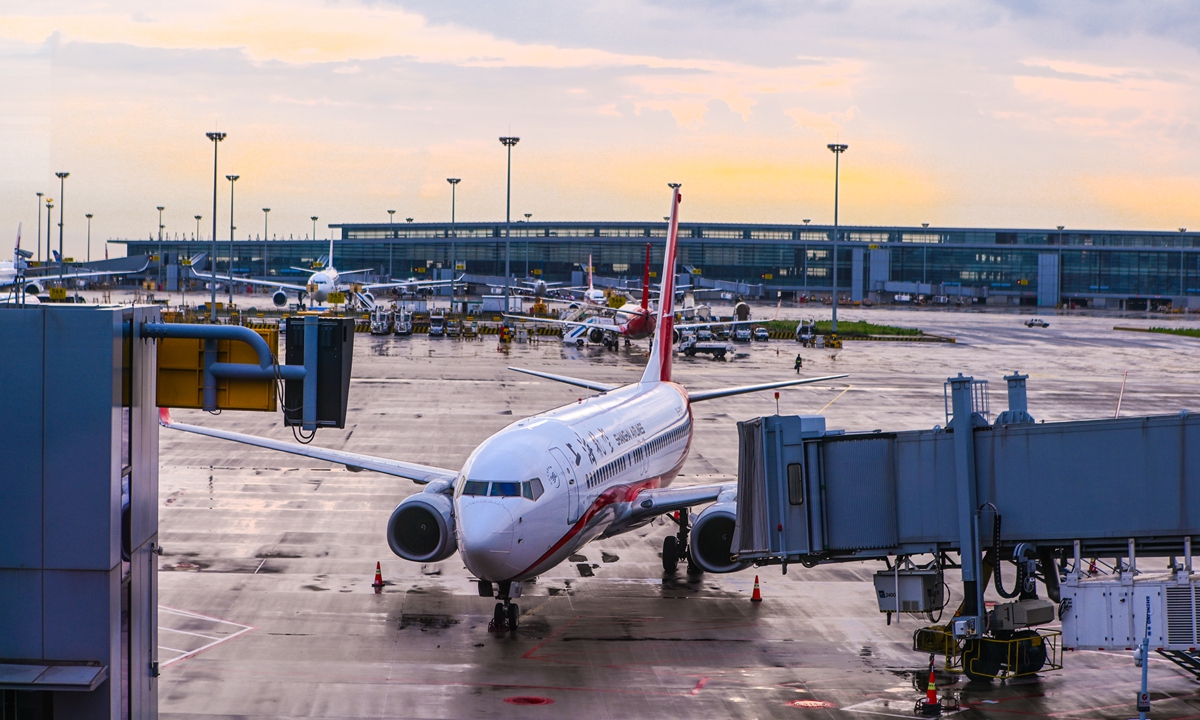Airport projects in China set to take off
Cities across China look to build, expand civil airports

Shanghai Pudong International Airport Photo: VCG
Several cities across China are welcoming a new round of airport construction projects in the new year. The projects range from airport expansion to new airport construction, spanning from South to East China, as cities look beyond the pressure generated by the ongoing pandemic.The fourth phase of the Shanghai Pudong International Airport expansion project formally began on Tuesday. After completion, the airport is forecast to be capabable of facilitating annual passenger throughput of 130 million passengers in 2030, and become a global benchmark for international aviation.
Also on Tuesday, Xiamen in East China's Fujian Province, launched its new airport construction project in Xiang'an. In total, eight projects started construction at the same time in Xiang'an, representing total investment of 62 billion yuan ($9.76 billion), covering aviation, infrastructure and socially-focused projects.
In terms of the airport, authorities in Fujian forecast the take off and landing of up to 380,000 flights per year, with an annual passenger throughput of 45 million, in addition to an annual cargo throughput of 750,000 tons.
Also on Tuesday, four key engineering projects including the No.1 freight forwarding depot within South China's Shenzhen airport intestified their work schedule, backed with a total investment of approximately 1.2 billion yuan.
Work across all these projects continues unabated despite the pandemic, with the government committing during the 14th Five-Year Plan period (2021-25) to adding more than 30 civil aviation airport facilities with a targeted capacity of 2 billion passengers.
Those projects cover key aviation markets including East China's Shanghai and Xiamen, South China's Guangzhou and Shenzhen, Northwest China's Xi'an and Urumqi, Southwest China's Chongqing, Central China's Changsha and North China's Hohhot.
Affected by the pandemic, air passenger and cargo transportation has fallen sharply over the past 24 months, the lower levels of activity have provided a rare opportunity and construction window for the expansion and upgrade of air transportation infrastructure, Qi Qi, a market insider told the Global Times on Wednesday.
A number of breakthroughs were made in the construction of aviaition-related projects in 2020. For example, the total investment of the third-phase expansion project of Guangzhou Baiyun International Airport reached 54.42 billion yuan, the largest reconstruction and expansion project in the history of civil aviation airport construction in China.
After completion, Baiyun airport will have five runways operating at the same time, the most runways of any airport in the country, and will also become home to China's largest airport terminal.
Compared with the 13th Five-Year Plan period (2016-20), the number of newly-built airports has decreased. According to data from the Civil Aviation Administration of China (CAAC), during 2016 to 2020, 43 airports were either built or relocated, 241 airports were granted permission to engage in nationwide operations, while total airport design capacity stood at 1.4 billion passengers.
Market watchers said that in the past 10 years, airports with sufficient flow of people have been built one after another, leading to a declining demand for the construction of large airports. Smaller, so-called branch airports are now the focus of China's next round of civil aviation infrastructure investment.
To beef up airline investment in regional airports, starting from the winter and spring of 2020, the CAAC has taken measures to loosen the entry limit for regional flights in three cities - Beijing, Shanghai and Guangzhou, while also streamlining transfer services to promote the development of regional aviation.
According to the map released by the government, the total number of national civil airports will reach about 400 by 2035, up from 241 in 2020, which means that during the next 15 years, China will add more than 150 airports, at an average of 10 new airports each year.
The race for new airports is also in line with Chinese policymakers' efforts to address economic "stability" to deal with challenges including shrinking demand, supply crunches, and downward pressure on economic growth.



